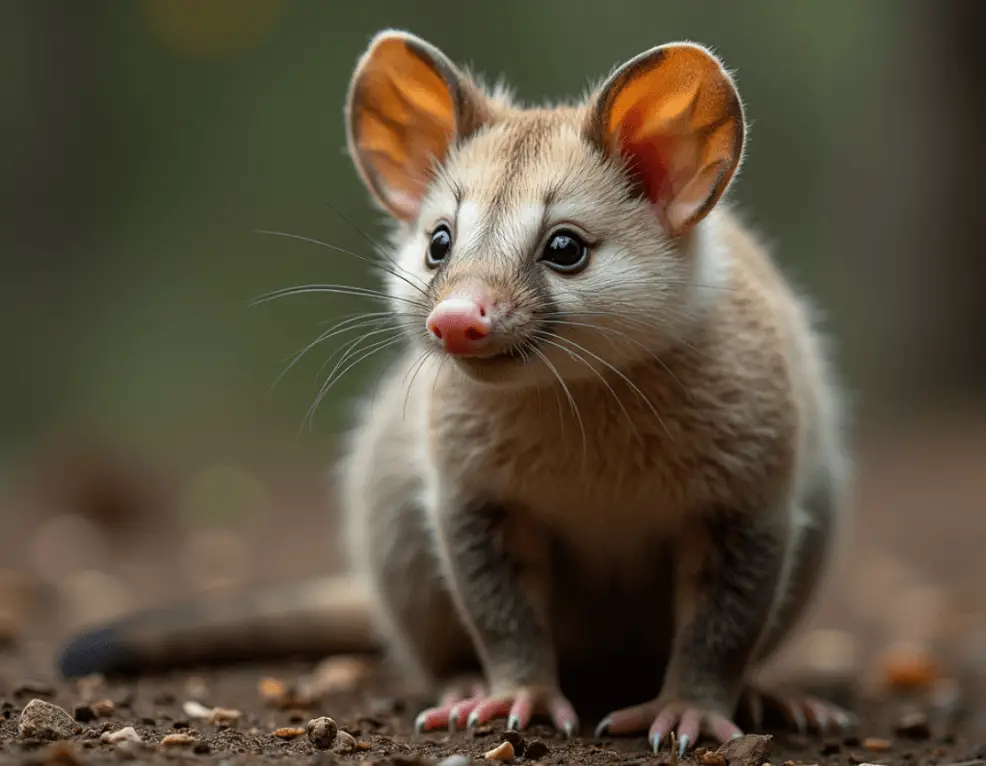The tñacuache, also known as the opossum or tlacuache, is a fascinating marsupial native to the Americas. This critter belongs to the family Didelphidae and is most commonly represented by the Virginia opossum (Didelphis virginiana).
These little guys can be found all over, from southern Canada down to Argentina, making their homes in forests, grasslands, and even city neighborhoods.
They’re pretty adaptable creatures! Tñacuaches come in various sizes, usually between 15 to 40 inches long, including their cool prehensile tail. Their fur is typically grayish-white, giving them a scruffy look.
These night owls are famous for their unique defense mechanism of “playing dead” when they feel threatened. Tñacuaches are omnivores, chowing down on fruits, insects, and small animals.
They play a big role in their ecosystems by controlling pests and spreading seeds. Despite being misunderstood sometimes, tñacuaches are actually helpful critters that keep things balanced in nature. So next time you spot one of these nocturnal neighbors, remember they’re just doing their part to keep our world running smoothly!
Tñacuache Physical Characteristics
The tñacuache, also known as the opossum, is a unique critter with some cool features. Let’s dive into what makes these little guys special!
Size and Weight
Tñacuaches come in different sizes, but most are about as big as a house cat. They usually measure between 15 to 30 inches long, including their tail. These furry friends can weigh anywhere from 4 to 14 pounds, with the boys often being a bit bigger than the girls.
Distinctive Features
One of the coolest things about tñacuaches is their prehensile tail. This special tail acts like an extra hand, helping them grab onto tree branches and carry stuff. It’s like having a built-in rope!
Their pointed snout is perfect for sniffing out food. And boy, do they have some sharp teeth! With 50 chompers, they’ve got more teeth than any other North American mammal.
Fur Color and Texture
Tñacuaches rock a grayish-white coat that’s pretty coarse. Their face is usually white with dark rings around their eyes, making them look like little masked bandits. Some folks say their fur feels a bit like a wire brush!
Unique Adaptations
These critters have some neat tricks up their sleeves. They’ve got opposable thumbs on their back feet, which makes them great climbers. And like kangaroos, they have a pouch where mama tñacuaches carry their babies.
Tñacuache Habitat and Distribution
Natural Environments
Tñacuaches are super adaptable. They love hanging out in forests where they can climb trees and find lots of hiding spots. You can also find them in grasslands, where they scurry around looking for tasty treats.
Urban and Suburban Adaptations
These clever animals have learned to live alongside humans too. They’re often spotted in cities and suburbs, where they might raid your trash can for a midnight snack. Some even make their homes in attics or under porches.
Range Across the Americas
Tñacuaches are all over the place! You can find them from southern Canada all the way down to northern Argentina. They’re especially common in Mexico and the United States. These little travelers have spread far and wide!
Fun Facts
Tñacuaches are great actors! When they’re scared, they can “play dead” to trick predators.
They’re immune to snake venom, which is pretty handy in the wild.
These night owls are mostly active after dark, using their good sense of smell to find food.
Tñacuaches might not win any beauty contests, but they’re super important for our ecosystems. They eat pests like ticks and help clean up by eating dead animals. So next time you spot one of these funny-looking critters, remember they’re just doing their job to keep nature in balance!
Tñacuache Behavior and Lifestyle
Night Owls on the Prowl
Tñacuaches are true night owls! These critters come alive when the sun goes down. They’re nocturnal, which means they do most of their business at night. This helps them stay safe from daytime predators like hawks and foxes.
During the day, tñacuaches catch some Z’s in cozy spots. They might snooze in hollow logs, tree holes, or even under your porch! When night falls, they wake up and start their adventures.
Solo Adventurers
These little guys are loners at heart. Tñacuaches prefer to fly solo, only hanging out with others during mating season. They’re not big on group activities and like to do their own thing.
Each tñacuache has its own turf that it marks and defends. They’re not into sharing their space or food with other tñacuaches.
Tree-Climbing Champs
Don’t let their clumsy looks fool you – tñacuaches are awesome climbers! They’ve got sharp claws and a cool prehensile tail that works like a fifth hand. This tail helps them grip branches and keep their balance as they scamper through the trees.
Their opposable thumbs on their back feet also make climbing a breeze. It’s like they’ve got built-in climbing gear!
The Famous Fake-Out
Now, here’s the tñacuache’s coolest trick – playing dead! When they’re super scared, they pull off an Oscar-worthy performance. They flop over, stick out their tongue, and even give off a stinky smell. This act is called thanatosis, and it’s so convincing that predators often lose interest and walk away.
A study found that tñacuaches who play dead longer are more likely to survive. It’s like a game of chicken with predators, and the tñacuaches often win!
Diet and Feeding Habits
Eating Everything and Anything
Tñacuaches aren’t picky eaters. They’re omnivores, which means they chow down on both plants and animals. Their menu is super varied – from juicy fruits to crunchy insects, and even small animals.
Here’s a taste of what’s on their plate:
- Fruits like apples and berries
- Insects like beetles and grasshoppers
- Small animals like mice and birds
- Eggs from bird nests
- Even garbage in cities!
Midnight Snack Hunters
When the sun sets, tñacuaches turn into food detectives. They use their super-sharp nose and good hearing to find tasty treats. These smart foragers can adapt to different environments, from forests to city streets.
In urban areas, they might raid your trash can for a midnight snack. But don’t get mad – they’re just trying to survive!
Nature’s Clean-Up Crew
Tñacuaches are like the janitors of the animal world. They eat dead animals (called carrion) that they find. This might sound gross, but it’s super important for keeping the environment clean.
By eating carrion, tñacuaches help stop diseases from spreading. They’re like a natural clean-up crew, recycling nutrients back into the ecosystem.
Pest Control Heroes
These little guys are secret superheroes when it comes to pest control. They munch on all sorts of critters that can be a nuisance to humans.
They eat ticks, helping to reduce Lyme disease
They gobble up rats and mice, which can spread diseases
They feast on insects that might damage crops
A single tñacuache can eat up to 5,000 ticks in one season. That’s a lot of pest control!
Reproduction and Life Cycle
The tñacuache, also known as the opossum, has a super cool way of having babies! Let’s dive into their unique baby-making process.
Marsupial Magic
Tñacuaches are marsupials, which means they’ve got a special pouch for their babies. Unlike other mammals, their reproductive system is like a double-decker bus – they have two uteruses and two vaginas. Talk about a wild ride!
Quick Bun in the Oven
When it comes to pregnancy, tñacuaches are speed demons. Their gestation period is only about 12 to 14 days. That’s faster than you can say “baby boom”!
Pouch Party
After the super-short pregnancy, tiny baby tñacuaches (called joeys) are born. They’re so small, you could fit a whole bunch on a teaspoon! These little guys crawl into mom’s pouch where they latch onto a teat and keep growing.
Growing Up Tñacuache
The joeys stay in the pouch for about two months. After that, they start to peek out and explore the world. By three to four months, they’re ready to party on their own.
Life in the Fast Lane
Tñacuaches live life in the fast lane. In the wild, they usually live for 1 to 2 years. But in captivity, where life’s a bit cushier, they can stick around for up to 4 years.
Ecological Significance
Tñacuaches might look a bit weird, but they’re nature’s little helpers. Let’s see how these critters make a big difference!
Seed Spreaders Extraordinaire
Tñacuaches are like nature’s gardeners. They munch on fruits and then spread the seeds as they move around. This helps new plants grow in different places.
Bug Busters and Rodent Police
These little guys are always hungry, and that’s good news for us! They chow down on insects and small animals, helping to keep pest populations in check.
City Slickers
Tñacuaches are tough cookies who can live in cities and towns. They help keep urban ecosystems balanced by eating pests and cleaning up leftovers.
Food Chain Superstars
In the wild food web, tñacuaches play a starring role. They’re food for bigger animals like owls and foxes, and they eat smaller critters too. It’s like they’re the middle managers of the animal kingdom!
Fun Facts and Figures
A female tñacuache can have up to 20 babies at once, but only about 13 survive.
Tñacuaches can eat up to 5,000 ticks in one season. That’s a lot of tick-tock for these tick-eaters!
These critters are immune to snake venom. They’re like real-life superheroes!
Tñacuaches might not win any beauty contests, but they sure are nature’s little helpers. From spreading seeds to keeping pests in check, these pouched pals are working hard to keep our ecosystems healthy.
So next time you spot a tñacuache, give them a thumbs up for being such awesome little eco-warriors!
Tñacuache in Urban Environments
City Slickers with Fur
Tñacuaches, also known as opossums, are nature’s ultimate city slickers. These furry friends have made themselves right at home in our urban jungles. They’re like the cool kids who can fit in anywhere!
Adapting to the Concrete Jungle
These little guys are super adaptable. They’ve learned to thrive in cities, using their smarts to find food and shelter. Tñacuaches are night owls, coming out when most folks are snoozing. This helps them avoid run-ins with humans and cars.
A study in Mexico City found that tñacuaches in built-up areas were actually healthier than their country cousins. Who knew city life could be good for you?
Making Friends (or Not) with Humans
Tñacuaches and humans have a complicated relationship. Some people think they’re pests, while others see them as helpful critters. These animals often raid trash cans for a midnight snack, which can ruffle some feathers.
But here’s the cool part: tñacuaches are like nature’s cleanup crew. They munch on insects, rodents, and even ticks. One tñacuache can gobble up to 5,000 ticks in a season. That’s a lot of Lyme disease prevention!
Urban Living: The Good, The Bad, and The Ugly
Living in cities has its ups and downs for tñacuaches. On the plus side, there’s plenty of food and cozy spots to crash. But city life comes with dangers too.
Traffic: Cars are a big threat. Many tñacuaches become roadkill.
Pets: Dogs and cats can attack them.
Pollution: City grime isn’t great for their health.
Keeping the Peace
To help tñacuaches and humans get along, we need some smart strategies:
Secure trash cans: This keeps tñacuaches out of trouble.
Wildlife corridors: Safe passages for animals to move around.
Education: Teaching people about how helpful tñacuaches are.
Conservation Status and Threats
How Are They Doing?
Good news! Tñacuaches are doing pretty well overall. They’re listed as “Least Concern” by the IUCN. That means they’re not in danger of going extinct anytime soon.
But don’t break out the party hats just yet. Tñacuaches still face some serious challenges.
City Sprawl and Habitat Loss
As cities grow, tñacuaches lose their natural homes. Forests and grasslands are turned into parking lots and shopping malls. This forces them to adapt or move out.
A study in the U.S. found that urbanization is a big driver of tñacuache range expansion. They’re moving to new areas to find food and shelter.
Danger on the Roads
Roads are like death traps for tñacuaches. Many get hit by cars when crossing streets. This is a major cause of death for these critters.
Helping Our Furry Friends
People are working hard to protect tñacuaches:
Wildlife crossings: Special bridges or tunnels for animals to cross roads safely.
Habitat protection: Saving green spaces in cities.
Rehab centers: Places that help injured tñacuaches recover.
Some cities are even creating tñacuache-friendly spaces. They’re planting trees and leaving some wild areas for these animals to live in.
Cultural Significance of Tñacuaches
The tñacuache, also known as the opossum, is a big deal in Mexican culture. These little critters have been part of stories and beliefs for a long time.
Folklore and Mythology
In Aztec myths, the tñacuache is a real hero. People say it stole fire from the gods to give to humans. That’s pretty brave! This story shows how clever and gutsy these animals are.
In some indigenous tales, tñacuaches are seen as tricksters. They outsmart bigger, stronger animals using their wits. These stories teach kids that being smart is just as important as being strong.
Modern Views
Today, some folks still think tñacuaches are cool, while others see them as pests. In cities, they might raid trash cans, which can bug people. But many are starting to see how helpful these animals really are.
Living with Tñacuaches
Tñacuaches and humans can totally get along! Here are some tips to make it work:
Tips for Homeowners
Secure your trash: Use bungee cords on your trash cans. This keeps tñacuaches out and your yard clean.
Don’t leave pet food outside: Feed your pets indoors to avoid attracting wildlife.
Trim trees: Keep branches away from your roof. This stops tñacuaches from using them as bridges to your house.
Creating Tñacuache-Friendly Spaces
Want to be a tñacuache buddy? Try these ideas:
Plant native trees and bushes: This gives them natural food and shelter.
Leave some wild areas: A messy corner of your yard can be a cozy spot for wildlife.
Use less pesticides: This keeps the bugs that tñacuaches eat healthy and safe.
Future Research and Conservation
Scientists are super excited about studying tñacuaches more. Here’s what they’re looking into:
Ongoing Studies
Researchers are checking out how tñacuaches act in cities. They want to know how these animals adapt to living near humans. This info can help us make better plans for wildlife in urban areas.
Health Benefits
Get this – tñacuaches might be good for our health! They eat tons of ticks, which can spread Lyme disease. One study found that areas with more opossums had fewer ticks and less Lyme disease. That’s pretty neat!
Public Education
Teaching people about tñacuaches is super important. When folks know how cool and helpful these animals are, they’re more likely to protect them. Schools, zoos, and nature centers can all help spread the word.
Conclusion
The tñacuache, also known as the opossum, plays a crucial role in ecosystems across the Americas. These adaptable marsupials are important seed dispersers, helping to spread plant species and maintain biodiversity.
By eating fruits and berries, tñacuaches distribute seeds through their droppings, promoting forest regeneration and plant diversity. They’re also nature’s pest controllers, consuming insects, rodents, and other small animals that could otherwise become problematic.
In urban areas, tñacuaches help keep cities clean by eating decaying matter and controlling pest populations. Their scavenging habits assist in reducing harmful bacteria and pathogens in the environment.
Despite facing threats from habitat loss and urban development, tñacuaches have shown remarkable resilience in adapting to human-altered landscapes.
Conservation efforts are important to protect these valuable ecosystem allies, including preserving their habitats and educating the public about their ecological importance.
By supporting tñacuache populations, we can help maintain healthier, more balanced ecosystems in both urban and rural areas.


